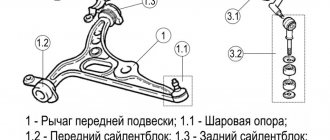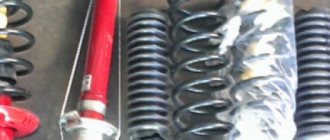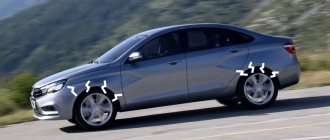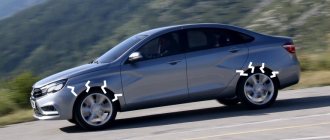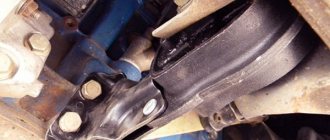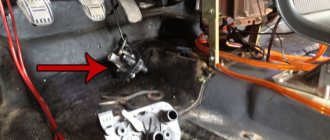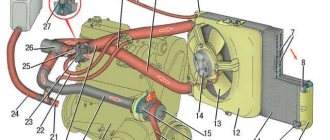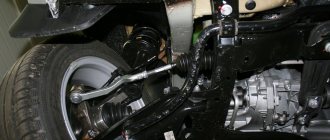Suspension or steering
A knock on small bumps does not always indicate a breakdown in the suspension. Similar sounds may come from the steering. You need to check the suspension and steering rack.
When this mechanism is faulty, vibration on the steering wheel is noticeable when driving on uneven roads. A large gap appears between the rack and gear, increasing over time, and vibration also increases. To get rid of the problem, you need to tighten the rail.
The problem may be related to the bushings on the tie rods. The parts need to be swung individually with a pry bar. If there is significant play, the element should be replaced.
If after tightening the rack and replacing the bushings the problem remains, you need to check the steering joint. For diagnostics, 2 people are needed: one must fix the hinge, body and pin, and the other must turn the steering wheel sharply at a small angle. If there is play, it will become clear that the mechanism requires replacement.
It is worth checking the steering rack ends. A sign of wear - a characteristic sound appears when the steering wheel is rotated while driving at a small angle, play is noticeable. The tips cannot be repaired; only replacement will help.
If the knock remains after the work, a full suspension diagnosis is required.
Front suspension diagram
Troubleshooting in the rack
Basically, the strut can make a knock and transmit impacts from uneven roads only when the entire structure is severely worn. Moreover, this element of the car suffers the most when the front pair of wheels falls into a deep hole - the rebound strut does not work, but the spring undergoes a sharp straightening. As a result, the wheel will go sharply down, stretching the spring to the maximum possible length. Thus, it turns out to be 2 hits - the racks against the support and the racks with the bottom of the pit.
Checking the functionality of the support pillar is carried out in a standard way - the vehicle is swung vertically or a partner presses forcefully on the central part of the hood. If the rack is in good condition, the body of the machine should return to its original state once without sharp straightening.
If the case falls sharply, you will hear a dull thud. This indicates a malfunction of the element due to a loose lock nut, which makes noise inside the support post itself. Repair of the rack should only be carried out at a car service center, since special equipment will be used to secure all elements in a high-quality manner.
If a knock occurs on small bumps due to the strut, the car sways strongly when moving and loses control. This may result in an accident on uneven roads.
Also, problems may lie not in the strut itself, but in the shock absorbers. A malfunction of the shock absorber system is primarily due to improper treatment with oil. Drivers often pour an oil solution with incorrect viscosity characteristics inside. This value is affected not only by the purchased oil, but also by the ambient temperature at which the solution is poured. Too low a temperature does not allow the oil fluidity to increase to the required value.
We recommend: Car diagnostics and repair
Stabilizer bushings
It is difficult to determine the breakdown of elements by sound. In order not to change the part, you need to check the bushing by hand. This can be done by a mechanic at a service station.
The malfunction can easily be confused with failed silent blocks. The difference is that if the bushings are installed on a subframe, the driver will feel vibration in his legs while driving.
Attention! It is impossible to check and replace the bushings on a lift; you need an inspection hole or platform so that the load is applied to the wheels.
If the parts are faulty, vibration will occur on any bumps.
Stabilizer's pole
The part is used to attach the stabilizer to the suspension. If there is a malfunction, the chassis begins to knock loudly. Knocks can be accompanied by strong car rolls when cornering, during acceleration and braking; it is necessary to constantly steer.
The breakdown occurs due to the anthers becoming unusable, moisture and dirt getting into the mechanism, and wear occurs.
To check the stabilizer links, you need to rock a stationary car. If this happens easily and with a knock, the part is faulty.
Another way to check is to turn the wheel and pull the rods. If there are gaps, it’s time to change the racks. Work should be done on a pit or platform for convenience.
It is important to check the anthers. If the mechanisms are torn, and there is moisture inside and there is no lubrication, it’s time to change the rack.
It is recommended to purchase a new part and replace it.
How to check silent blocks?
A flat mount will be required for diagnosis. This will allow you to determine how badly these parts are worn. Using the mount, the lever will move in the longitudinal and transverse directions. If there is play or damage, then the front suspension silent blocks are to blame for the knocking.
Sometimes the levers can be collapsible. Then you can replace it with a silent block. To do this, the lever is dismantled, and then, using a special mandrel, the part is squeezed out. It is advisable to lubricate the new silent block before installation. The seating surface must also be cleaned. After installation, the knocking should stop.
Checking silent blocks
Car suspensions contain levers whose structure contains silent blocks. Elements are necessary for attaching shock absorbers.
Over time, the part wears out and cannot fulfill its role. “Rolling” appears and the car handles worse. When the silent block becomes unusable, play occurs.
To check the part you need a jack and a pry bar. Necessary:
- Raise the car so that the wheel is hanging out.
- Using a pry bar, loosen the suspension arms, checking for play.
If there is a gap and is accompanied by knocking noises, the part is faulty and needs replacement. It is necessary to check both silent blocks.
Attention! The parts wear out evenly, it is recommended to change them together, even if one does not play.
The process is simple: you need to remove the levers and dismantle the silent blocks. You will need a special tool.
Malfunction in the lever system
Very often the problem is wear of the silent blocks of the levers.
As a result of their wear, the system begins to “play” and knock. At the same time, the car’s controllability deteriorates, and accordingly, traffic safety is greatly reduced. To troubleshoot silent blocks, you will need a jack and a pry bar. First of all, you need to jack up the wheel to hang it completely. Then use the pry bar as a lever, applying load to the suspension arms in different directions, i.e. shaking them from side to side. If play with a dull tapping sound is detected, then your diagnosis is correct. In the same way, you need to check the levers of the second wheel.
As a rule, parts wear out evenly. Therefore, if you find problems on one side, there are probably problems on the other side to a greater or lesser extent. To fix the problem, you just need to replace the silent blocks (rubber-metal hinges). The diagram above shows a front suspension arm with silent blocks on a Lada Vesta.
You can even replace the hinges yourself. To do this, first of all it is necessary to dismantle the levers. To remove the old joints from the arms and install new ones, you will need a special tool designed specifically for your make and model of car.
Spherical bearing
The front suspension of passenger cars has 2 ball joints - one for each wheel. signs of malfunction:
- The steering wheel turns harder.
- Knocks are heard in the front suspension when driving.
- Controllability deteriorates, the wheels “float”.
- The rubber tread wears off intensively.
- Wheel alignment is not displayed.
You can determine if the ball joints are faulty by diagnostics: hang the car wheel with a jack or on a lift, hold down the brake pedal, and turn the wheel from the outside. The procedure must be carried out together.
If, during a sharp turn, play appears, accompanied by a knocking sound, an urgent replacement of the ball joints is necessary. The anthers should be checked. The parts must be intact, otherwise they will become unusable.
Rack
Very often, knocking in the front suspension on small bumps is attributed to this particular unit. In reality, the stand is the source of knocking in very, very rare cases. But it’s worth checking, because this is a very important unit.
A heavily worn, very weak strut, even if it has not yet leaked, can cause shocks. When the car moves and the wheels fall into a hole, the rebound force of this strut is not enough, and it is not able to prevent the spring from straightening. The stand shoots the wheel down. When the wheel either touches the hole or hangs in the air, it stretches to its maximum. There will be a blow in both the first and second cases.
Wheel bearings
The initial stage of breakdown is accompanied by a hum. To make sure that the wheel bearings are faulty, you need to accelerate the car to 50 km/h and perform the “snake” exercise, turning the steering wheel slightly. If you hear a hum, the parts are broken. On which side the sound is stronger, on that side the part is worn out more.
Diagnostics is possible using special equipment, or you can perform the procedure yourself. Necessary:
- Raise the front axle of the car.
- Grab the wheel from above and below with your hands.
- Try tilting.
If the bearing is good, the wheel will be fixed and will not move. The presence of play means the part has become unusable. The problem may arise from the steering rack.
Attention! For vehicles with a front drive axle, the wheels are checked vertically and horizontally.
You cannot continue operating the machine with faulty bearings. The breakdown must be repaired, otherwise the mechanism may suddenly jam.
Signs of bad wheel bearings
Brake problems
If a knocking noise occurs when you press or lower the brake pedal, there is a problem with the ABS (anti-lock braking system). This nuance arises after repair work was performed incorrectly.
Brake problems:
- Damage to the seats for the caliper guides, which is loose and vibrates. Parts need to be replaced.
- Caliper piston jamming. The element hits the pads sharply, causing a knocking sound. The piston changes.
- Brake disc guidance. Due to high temperatures, the part may change shape and bend. The pads begin to wear unevenly. You need to check the disk on special equipment in order to replace it in time.
- The pad retainer has come off and will hit the drum, creating a knocking sound. The part needs to be installed in place and the cause of the jumping off must be determined.
The problem is related to a malfunction in the ABS. It is enough to remove the corresponding fuse from the block. If after carrying out the actions the knocking stops, the ABS is faulty. Specialists can fix the problem; there is no need to try to fix it yourself.
Brakes as a source of knocking
Sometimes sounds coming from the suspension are actually coming from the brakes. It happens that a car enthusiast has checked everything and replaced everything that can be replaced. The front suspension layout has already been learned by heart, but the knocking was still there.
To make a diagnosis, you need to move. If the knocking noise disappears when braking, and when the pedal is released, it resumes again, then the brake pads are to blame. The same problems can occur after installing new pads.
If the car is knocking, do not rush to repair the chassis. Perhaps the extraneous sound is caused by a completely different reason. In this case, only a complete diagnosis can help. It may be enough to replace the front suspension silent blocks and the sound will disappear forever.
Engine support cushions
The pillows contain rubber elements that wear out over time. Because of this, the car rattles when driving.
You need to open the hood and start the engine. Strong vibration indicates that the parts have become unusable. If the engine shakes or tilts more when you press the gas, it's time to change the elements.
You can check the integrity of the pillows yourself without visually. You need to try to shake the power unit. If the action can be performed without effort, it’s time to change the pillows.
You should not ignore such a breakdown; due to the force of vibration, various components are destroyed. When the part becomes unusable, the motor breaks off its mounts, and serious repairs will be required.
You can change the pillows yourself. Without work experience, you should contact the experts.
